Service Learning as an Education for Sustainable Development (ESD) Teaching Strategy: Design, Implementation, and Evaluation in a STEM University Course
Abstract
:1. Introduction
1.1. SL and Other Experiential Practices
1.2. SL Methodology in the Study of Science
1.3. SL Methodology at the University Level
2. Methodology
2.1. Sample
2.2. SL Project as Intervention
2.3. Instrument
2.4. Statical and Data Analysis
3. Results
3.1. Results on Knowledge of SL and Innovative Methodologies
3.2. Impact on Knowledge of the SDGs
4. Discussion
5. Conclusions
Author Contributions
Funding
Institutional Review Board Statement
Informed Consent Statement
Data Availability Statement
Acknowledgments
Conflicts of Interest
References
- Fleming, L.; Leonardi, G.; White, M.; Medlock, J.; Alcock, I.; Macintyre, H.; Maguire, K.; Nichols, G.; Wheeler, B.; Morris, G.; et al. Beyond Climate Change and Health: Integrating Broader Environmental Change and Natural Environments for Public Health Protection and Promotion in the UK. Atmosphere 2018, 9, 245. [Google Scholar] [CrossRef] [Green Version]
- Yusuf, R.; Fajri, I. Differences in Behavior, Engagement and Environmental Knowledge on Waste Management for Science and Social Students through the Campus Program. Heliyon 2022, 8, e08912. [Google Scholar] [CrossRef]
- Sulich, A.; Sołoducho-Pelc, L.; Ferasso, M. Management Styles and Decision-Making: Pro-Ecological Strategy Approach. Sustainability 2021, 13, 1604. [Google Scholar] [CrossRef]
- Keeble, B.R. The Brundtland Report: ‘Our Common Future’. Med. War 1988, 4, 17–25. [Google Scholar] [CrossRef]
- Uvalić-Trumbić, S. New Dynamics of Higher Education and Research for Societal Change and Development. Organ. Znanja 2009, 12, 128–132. [Google Scholar] [CrossRef]
- Water, U.N. (Ed.) Water and Climate Change. In The United Nations World Water Development Report; UNESCO: Paris, France, 2020; ISBN 978-92-3-100371-4. [Google Scholar]
- Jickling, B.; Wals, A.E.J. Globalization and Environmental Education: Looking beyond Sustainable Development. J. Curric. Stud. 2008, 40, 1–21. [Google Scholar] [CrossRef]
- Gallini, S.M.; Moely, B.E. Service-Learning and Engagement, Academic Challende, and Retention. Mich. J. Community Serv. Learn. 2003, 10, 5–14. [Google Scholar]
- Dienhart, C.; Maruyama, G.; Snyder, M.; Furco, A.; McKay, M.S.; Hirt, L.; Huesman, R. The Impacts of Mandatory Service on Students in Service-Learning Classes. J. Soc. Psychol. 2016, 156, 305–309. [Google Scholar] [CrossRef]
- Bringle, R.G.; Steinberg, K. Educating for Informed Community Involvement. Am. J. Community Psychol. 2010, 46, 428–441. [Google Scholar] [CrossRef] [Green Version]
- Felten, P.; Clayton, P.H. Service-Learning. New Dir. Teach. Learn. 2011, 2011, 75–84. [Google Scholar] [CrossRef]
- Rodríguez Gallego, M.R. El Aprendizaje-Servicio Como Estrategia Metodológica En La Universidad. Rev. Complut. Educ. 2014, 25, 95–113. [Google Scholar] [CrossRef] [Green Version]
- Sigmon, R.L. Journey to Service-Learning Experiences from Independent Liberal Arts Colleges and Universities; Distributed by ERIC Clearinghouse: Place of publication not identified; Council of Independent Colleges: Washington, DC, USA, 1996; ISBN 978-0-937012-12-3. [Google Scholar]
- Sotelino Losada, A. Evaluación y Propuesta de Desarrollo; Aprendizaje-Servicio En Las Universidades Gallegas: Santiago de Compostela, Spain, 2014; Available online: https://plataformavoluntariado.org/wp-content/uploads/2019/04/tesese-sotelino.pdf (accessed on 6 June 2022).
- Billig, S.; Furco, A. Service-Learning through a Multidisciplinary Lens; Advances in Service-Learning Research; Information Age: Greenwich, CT, USA, 2002; ISBN 978-1-931576-80-2. [Google Scholar]
- Mayor Paredes, D. El Aprendizaje-Servicio Como Práctica Educativa Que Promueve Relaciones Colaborativas Entre La Escuela y La Comunidad. Estudio de Caso. Ph.D. Thesis, Universidad de Almeria, Almeria, Spain, 2016. [Google Scholar]
- Puig Rovira, J.M.; Palos Rodríguez, J. Rasgos Pedagógicos Del Aprendizaje-Servicio. Cuad. Pedagog. 2006, 357, 60–63. [Google Scholar]
- Martínez-Campillo, A.; Sierra-Fernández, M.d.P.; Fernández-Santos, Y. Service-Learning for Sustainability Entrepreneurship in Rural Areas: What Is Its Global Impact on Business University Students? Sustainability 2019, 11, 5296. [Google Scholar] [CrossRef] [Green Version]
- Carver, R.L. Theoretical Underpinnings of Service Learning. Theory Pract. 1997, 36, 143–149. [Google Scholar] [CrossRef]
- Luna, E. Del Centro Educativo a La Comunidad: Un Programa de Aprendizaje-Servicio Para El Desarrollo de Ciudadanía Activa, Barcelona, Spain. 2010. Available online: https://dialnet.unirioja.es/servlet/tesis?codigo=85430&orden=3&info=link (accessed on 6 June 2022).
- Mayor Paredes, D.; Rodríguez Martínez, D. Aprendizaje-Servicio y Práctica Docente: Una Relación Para El Cambio Educativo. Rev. Investig. Educ. 2016, 34, 535. [Google Scholar] [CrossRef]
- Rahima, C. Community Service-Learning: A Guide to Including Service in the Public School Curriculum; SUNY Series; Democracy and Education; Wade, R.C., Ed.; State University of New York Press: Albany, Australia, 1997; ISBN 978-0-7914-3184-9. [Google Scholar]
- Tapia, M.N. Civic Service in South America. Nonprofit Volunt. Sect. Q. 2004, 33, 148S–166S. [Google Scholar] [CrossRef]
- Celio, C.I.; Durlak, J.; Dymnicki, A. A Meta-analysis of the impact of Service-Learning on Students. J. Exp. Educ. 2011, 34, 164–181. [Google Scholar] [CrossRef]
- Welch, M.; Billig, S. New Perspectives in Service-Learning: Research to Advance the Field; Advances in Service-Learning Research; Welch, M., Billig, S., Eds.; Information Age Publishing: Greenwich, CT, USA, 2004; ISBN 978-1-59311-158-8. [Google Scholar]
- Jeong, J.S.; González-Gómez, D. A web-based tool framing a collective method for optimizing the location of a renewable energy facility and its possible application to sustainable STEM education. J. Clean. Prod. 2020, 251, 119747. [Google Scholar] [CrossRef]
- Jeong, J.S.; González-Gómez, D. A STEM Course Analysis During COVID-19: A Comparison Study in Performance and Affective Domain of PSTs Between F2F and F2S Flipped Classroom. Front. Psychol. 2021, 12, 669855. [Google Scholar] [CrossRef]
- National Committee on Science Education Standards and Assessment; Board on Science Education; Division of Behavioral and Social Sciences and Education; National Research Council. National Science Education Standards; National Academies Press: Washington, DC, USA, 1996; p. 4962. ISBN 978-0-309-05326-6. [Google Scholar]
- Billig, M. Critical Discourse Analysis and the Rhetoric of Critique. In Critical Discourse Analysis; Weiss, G., Wodak, R., Eds.; Palgrave Macmillan UK: London, UK, 2003; pp. 35–46. ISBN 978-0-230-55514-3. [Google Scholar]
- González-Gómez, D.; Jeong, J.S. EdusciFIT: A computer-based blended and scaffolding toolbox to support numerical concepts for flipped science education. Educ. Sci. 2019, 9, 116. [Google Scholar] [CrossRef] [Green Version]
- Caride, J.A.; Meira, P.Á. Del Ecologismo Como Movimiento Social a La Educación Ambiental Como Construcción Histórica. Hist. Educ. 2019, 37, 165. [Google Scholar] [CrossRef]
- Molano Niño, A.C.; Herrera Romero, J.F. La Formación Ambiental En La Educación Superior: Una Revisión Necesaria. Luna Azul 2014, 39, 186–206. [Google Scholar] [CrossRef]
- Jeong, J.S.; González-Gómez, D. Assessment of sustainability science education criteria in online-learning through fuzzy-operational and multi-decision analysis and professional survey. Heliyon 2020, 6, e04706. [Google Scholar] [CrossRef] [PubMed]
- Cebrián Bernat, G.; Junyent Pubill, M. Competencias Profesionales En Educación Para La Sostenibilidad: Un Estudio Exploratorio de La Visión de Futuros Maestros. Enseñ. Las Cienc. 2014, 32, 29–49. [Google Scholar] [CrossRef] [Green Version]
- Rieckmann, M. Future-Oriented Higher Education: Which Key Competencies Should Be Fostered through University Teaching and Learning? Futures 2012, 44, 127–135. [Google Scholar] [CrossRef]
- Wiek, A.; Withycombe, L.; Redman, C.L. Key Competencies in Sustainability: A Reference Framework for Academic Program Development. Sustain. Sci. 2011, 6, 203–218. [Google Scholar] [CrossRef] [Green Version]
- Jeong, J.S.; González-Gómez, D. Multi-Criteria Decision Analysis Methods for Sustainability Assessment of Renewable Energy Systems and Its Potential Application to Sustainable STEM Education. In Energy Systems Evaluation; Green Energy and Technology; Ren, J., Ed.; Springer: Cham, Switzerland, 2021; Volume 2. [Google Scholar] [CrossRef]
- Hewitt, N. ; International Council for Local Environmental Initiatives. Guía Europea Para la Planificación de las Agendas 21 Locales: Como Implicarse en un Plan de Acción Ambiental a Largo Plazo Hacia la Sostenibilidad; Bakeaz: Bilbao, Spain, 1998; ISBN 978-84-88949-25-7. [Google Scholar]
- Hernández-Barco, M.; Sánchez-Martín, J.; Blanco-Salas, J.; Ruiz-Téllez, T. Teaching Down to Earth—Service-Learning Methodology for Science Education and Sustainability at the University Level: A Practical Approach. Sustainability 2020, 12, 542. [Google Scholar] [CrossRef] [Green Version]
- López Aguado, M. Estrategias de Aprendizaje En Estudiantes Universitarios. Diferencias Por Género, Curso y Tipo de Titulación. Educ. Knowl. Soc. EKS 2011, 12, 203–233. [Google Scholar] [CrossRef]
- Mella-Núñez, Í.; Quiroga-Carrillo, A.; Crespo Comesaña, J. Aprendizaje-Servicio y Desarrollo Cívico-Social En Titulaciones Universitarias Del Ámbito Educativo: Preparando al Alumnado Para La Práctica de Una Educación Inclusiva. Educar 2021, 57, 363–377. [Google Scholar] [CrossRef]
- Álvarez Castillo, J.L.; Martínez Usarralde, M.J.; González González, H.; Buenestado Fernández, M. El Aprendizaje-Servicio En La Formación Del Profesorado de Las Universidades Españolas. Rev. Esp. Pedagog. 2017, 75, 199–217. [Google Scholar] [CrossRef]
- Zamora-Polo, F.; Sánchez-Martín, J. Teaching for a better world. Sustainability and sustainable development goals in the construction of a change-maker university. Sustainability 2019, 11, 4224. [Google Scholar] [CrossRef] [Green Version]
- Seba, D. The impact of the type of project on preservice teacher’s conceptualization for service-learning. Teach. Teach. Educ. 2013, 32, 87–97. [Google Scholar] [CrossRef]
- Hebert, A.; Hauf, P. Student learning through service learning: Effects on academic development, civic responsibility, interpersonal skills and practical skills. Act. Learn. High. Educ. 2015, 16, 37–49. [Google Scholar] [CrossRef]
- Kahne, J.; Westheimer, J.; Rogers, B. Service learning and citizenship in higher education. Mich. J. Community Serv. Learn. 2000, 7, 42–51. [Google Scholar]
- Melaugh, C.T.; Kindschuh, T. Engaged in waste: Two case studies from Protland state linking operational sustainability and studente-community engagement. In University-Community Partnerships; Wortham-Galvin, B.D., Allen, J.H., Sherman, J.D.B., Eds.; Routledge: London, UK, 2017; Volume 52, pp. 196–206. [Google Scholar]
- Benning, J.L.; Surovek, A.E.; Shearer, C.R. Engagement in practice: A case study on improving community sustainability through service-learning. In Proceedings of the 2018 ASEE Annual Conference, Salt Lake City, UT, USA, 24–27 June 2018; Volume 11, pp. 331–349. [Google Scholar]
- Martínez-Valdivia, E.; Burgos-Garcia, A. Academic Causes of School Failure in Secondary Education in Spain: The Voice of the Protagonists. Soc. Sci. 2020, 9, 11. [Google Scholar] [CrossRef] [Green Version]
- Matzembacher, E.D.; Gonzales, R.L.; do Nascimento, L.F. From informing to practicing: Students’ engagement through practice-based learning methodology and community services. Int. J. Mang. Educ. 2019, 17, 191–200. [Google Scholar] [CrossRef]
- González-Gómez, D.; Jeong, J.S.; Cañada-Cañada, F. Examining the Effect of an Online Formative Assessment Tool (OFAT) of Students’ Motivation and Achievement for a University Science Education. J. Balt. Sci. Eudc. 2020, 19, 401–414. [Google Scholar] [CrossRef]
- Jeong, J.S.; González-Gómez, D. Flipped-OCN method in mathematics learning to analyze the attitudes of pre-service teachers. Mathemtatics 2021, 9, 607. [Google Scholar] [CrossRef]
- González-Gómez, D.; Jeong, J.S. The Flipped Learning Model in General Science: Effects on Students’ Learning Outcomes and Affective Dimensions. In Active Learning in College Science; Mintzes, J., Walter, E., Eds.; Springer: Cham, Switzerland, 2020. [Google Scholar] [CrossRef]
- Foshee Holmens, A.; Webb, K.J.; Albritton, B.R. Connecting students to community: Engaging students through course embedded service-learning activities. Int. J. Manag. Educ. 2022, 20, 100610. [Google Scholar] [CrossRef]
- Castro, P.; Are-Pernas, A.; Depena, A. Service-Learning project in university degrees based on sustainable development goals: Proposals and results. Susstainability 2020, 12, 7940. [Google Scholar] [CrossRef]
- Günther, J.; Overbeck, A.K.; Muster, S.; Tempel, B.J.; Shaa, S.; Schaal, S.; Kühner, E.; Otto, S. Outcome indicator development: Defining education for sustainable development outcomes for the individual level and connecting them to the SDGs. Global Environ. Change 2022, 74, 102526. [Google Scholar] [CrossRef]
- Killian, S.; Lannon, J.; Murray, L.; Avran, G.; Giralt, M.; O’Riordan, S. Social Media for social good: Student engagment for the SDGs. Int. J. Manag. Educ. 2019, 17, 100307. [Google Scholar] [CrossRef]
- Restrepo, E. Cuestiones de Método: «eventualización» y Problematización En Foucault. Tabula Rasa 2008, 8, 111–132. [Google Scholar] [CrossRef]
- Armstrong, A.G.; Mattson, C.A.; Lewis, R.S. Factors leading to sustainable social impact on the affected communities of engineering service-learning projects. Dev. Eng. 2021, 6, 100066. [Google Scholar] [CrossRef]
- García-Rico, L.; Martínez-Muñoz, L.F.; Santos-Pastor, M.L.; Chiva-Bartol, O. Service-learning in physical education teacher education: A pedagogical model towards sustainable development goals. Int. J. Sustain. High. Educ. 2021, 22, 747–765. [Google Scholar] [CrossRef]
- Molderez, I.; Fonseca, E. The efficacy of real-world experiences and service learning for fostering competences for sustainable development in higher education. J. Clean. Prod. 2018, 172, 4397–4410. [Google Scholar] [CrossRef]
- Howell, R.A. Engaging students in education for sustainable development: The benefits of active learning, reflective practices and flipped classroom pedagogies. J. Clean. Prod. 2021, 325, 129318. [Google Scholar] [CrossRef]
- Barth, M.; Adomßent, M.; Fischer, D.; Richter, S.; Rieckmann, M. Learning to change universities from within: A service-learning perspective on promoting sustainable consumption in higher education. J. Clean. Prod. 2014, 62, 72–81. [Google Scholar] [CrossRef] [Green Version]
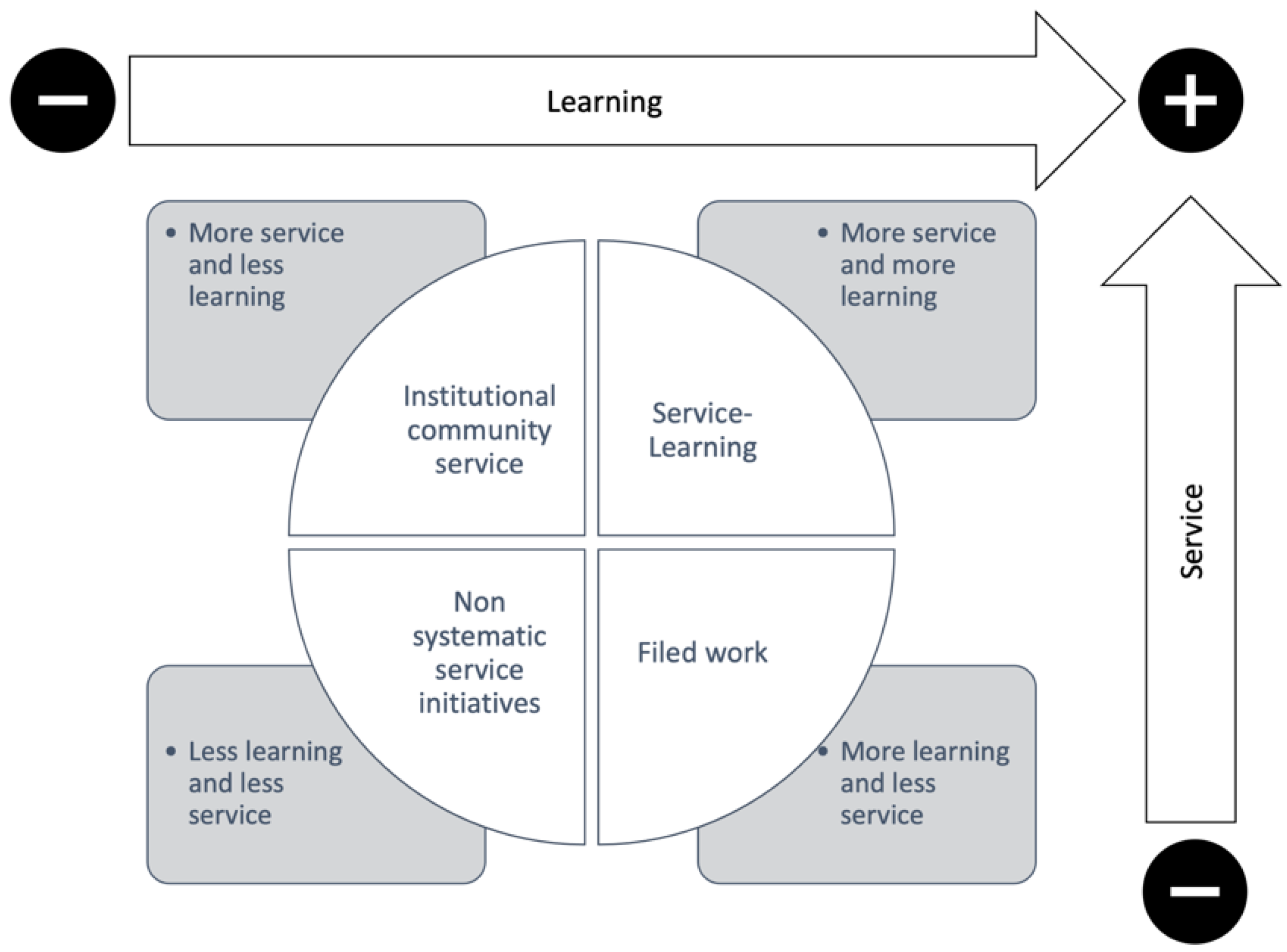
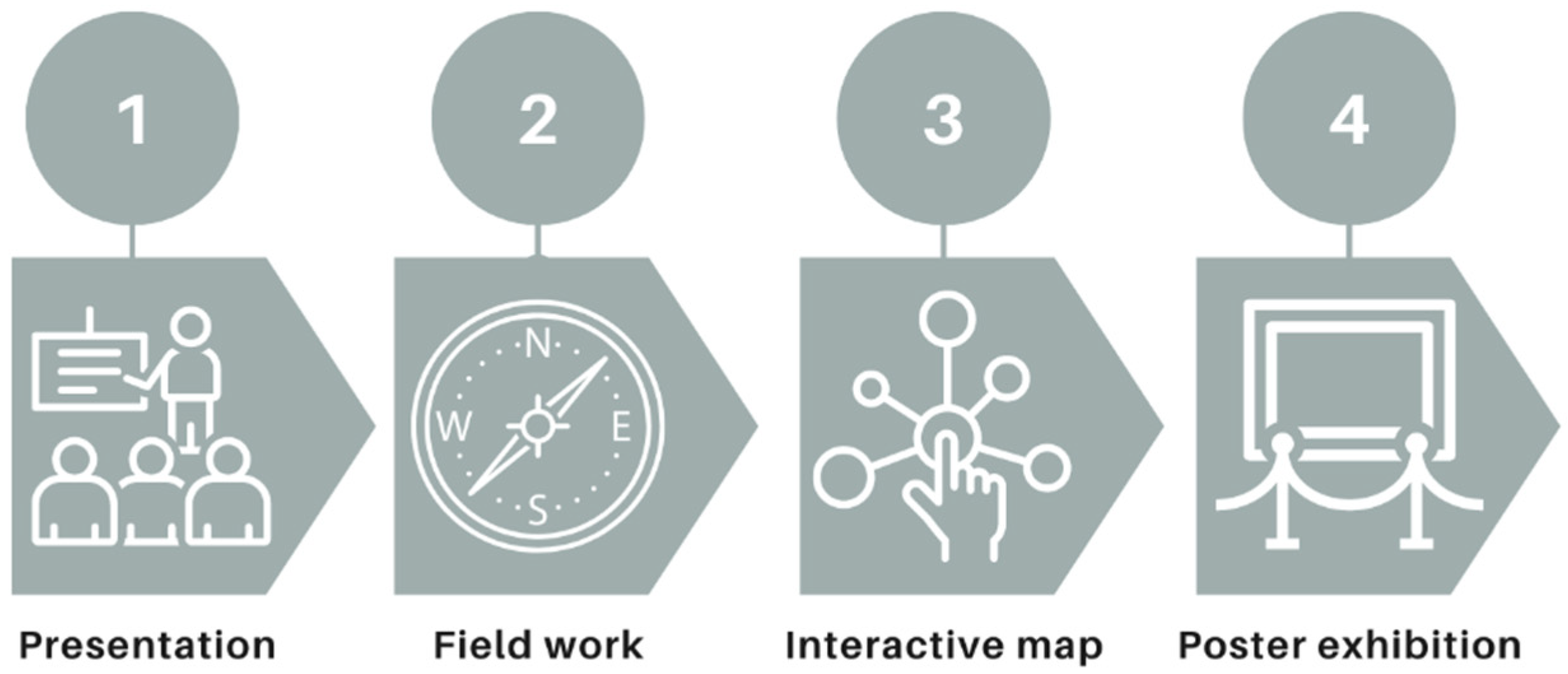
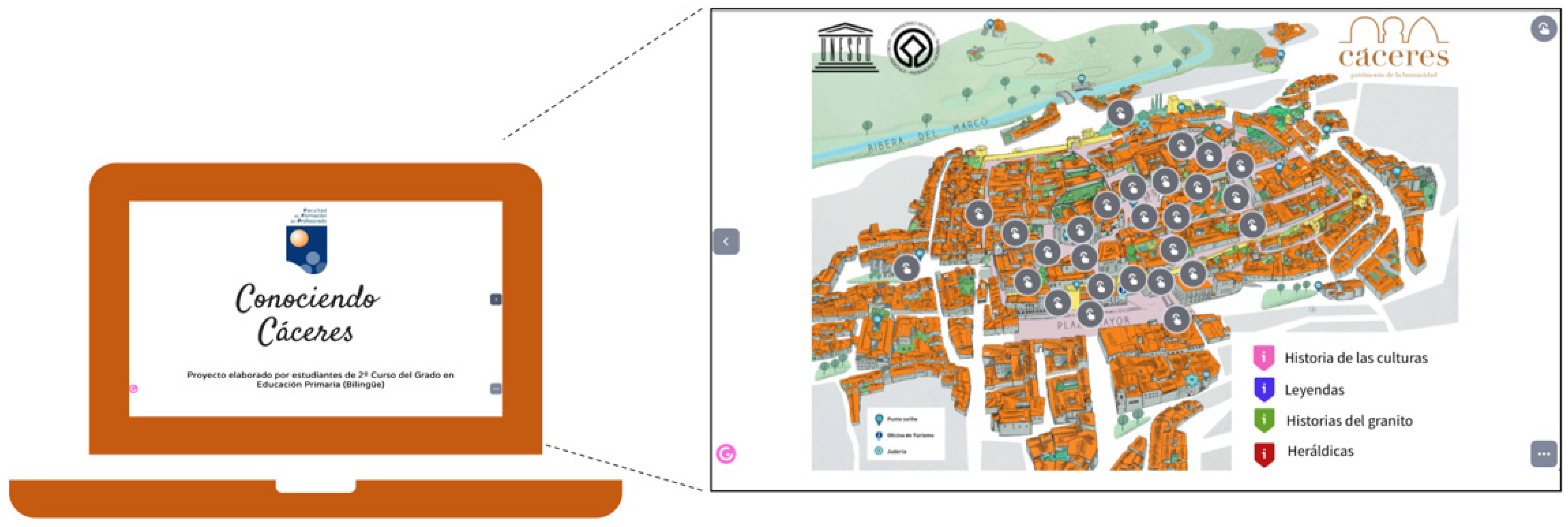
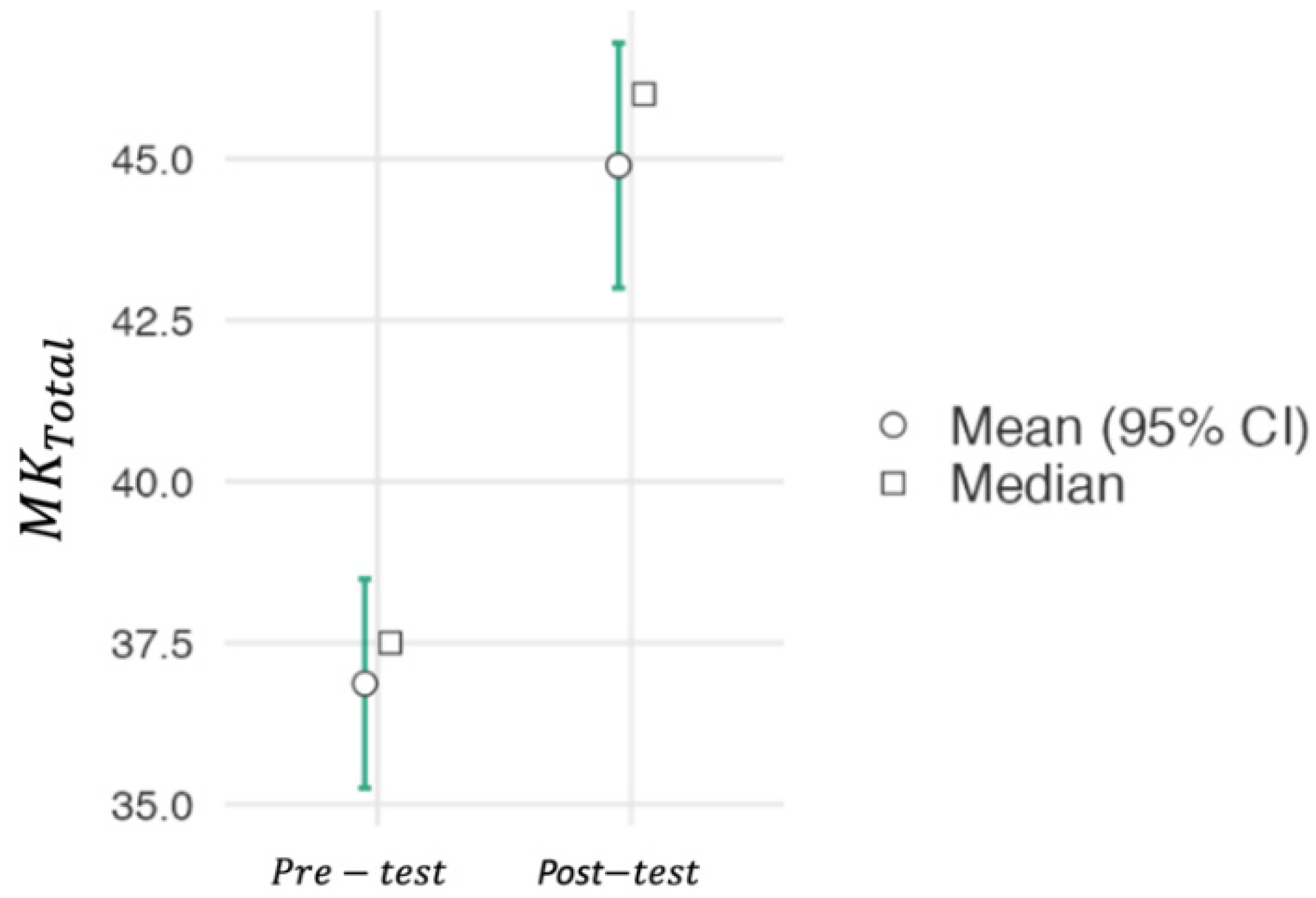
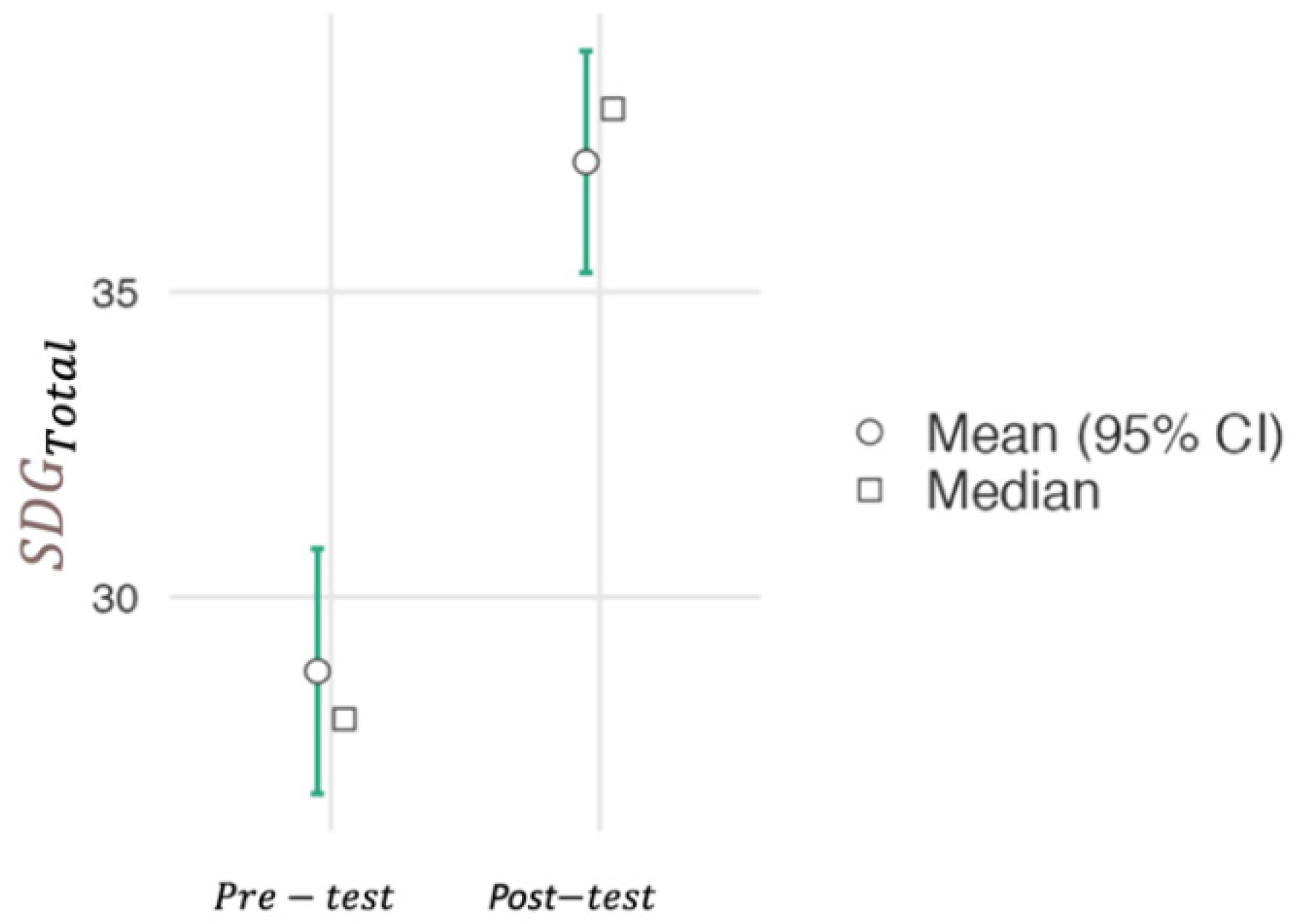
| N | Gender (%) | Age (%) | Educational Background (%) | |||||
|---|---|---|---|---|---|---|---|---|
| Male | Female | 19–21 | 22–25 | >25 | Social Sciences | Science | Technology | |
| 46 | 30.43 | 69.56 | 89.13 | 8.69 | 2.17 | 41.32 | 54.34 | 4.34 |
| MK Item Questionnaire | SDGK Item Questionnaire | ||
|---|---|---|---|
| MK_1 | I know the SL methodology. | SDG_1 | How familiar are you with the concept of SDGs? |
| MK_2 | I know how to design an educational project with active methodologies. | SDG_2 | You have a strong interest in learning about the SDGs. |
| MK_3 | I have sufficient teaching tools/knowledge to teach with innovative methodologies. | SDG_3 | I know what the SDGs are. |
| MK_4 | I feel motivated by the tasks I carry out in my teacher training process at the university. | SDG_4 | I recognise the necessities of my environment in terms of what the SDGs dictate. |
| MK_5 | I try to involve the community in the educational projects/activities I design. | SDG_5 | I am aware of the environmental and heritage problems in my community. |
| MK_6 | I feel calm when I have to make public presentations. | SDG_6 | I feel responsible for certain environmental problems around me. |
| MK_7 | I value the city of Cáceres positively. | SDG_7 | I participate in activities (e.g., lectures and activities) about sustainability and heritage. |
| MK_8 | I know the history and culture of the city of Cáceres. | SDG_8 | I believe that caring for the environment and culture is a high cost for public administrations. |
| MK_9 | I have studied the history and heritage of my city/town throughout my academic training. | SDG_9 | I am interested in taking care of my city’s heritage. |
| MK_10 | I encourage respect and care for the environment in my teaching activities. | SDG_10 | I encourage care for the cultural heritage of my city. |
| MK_11 | I contribute in some way to the care of my city. |
Publisher’s Note: MDPI stays neutral with regard to jurisdictional claims in published maps and institutional affiliations. |
© 2022 by the authors. Licensee MDPI, Basel, Switzerland. This article is an open access article distributed under the terms and conditions of the Creative Commons Attribution (CC BY) license (https://creativecommons.org/licenses/by/4.0/).
Share and Cite
Martín-Sánchez, A.; González-Gómez, D.; Jeong, J.S. Service Learning as an Education for Sustainable Development (ESD) Teaching Strategy: Design, Implementation, and Evaluation in a STEM University Course. Sustainability 2022, 14, 6965. https://doi.org/10.3390/su14126965
Martín-Sánchez A, González-Gómez D, Jeong JS. Service Learning as an Education for Sustainable Development (ESD) Teaching Strategy: Design, Implementation, and Evaluation in a STEM University Course. Sustainability. 2022; 14(12):6965. https://doi.org/10.3390/su14126965
Chicago/Turabian StyleMartín-Sánchez, Alberto, David González-Gómez, and Jin Su Jeong. 2022. "Service Learning as an Education for Sustainable Development (ESD) Teaching Strategy: Design, Implementation, and Evaluation in a STEM University Course" Sustainability 14, no. 12: 6965. https://doi.org/10.3390/su14126965
APA StyleMartín-Sánchez, A., González-Gómez, D., & Jeong, J. S. (2022). Service Learning as an Education for Sustainable Development (ESD) Teaching Strategy: Design, Implementation, and Evaluation in a STEM University Course. Sustainability, 14(12), 6965. https://doi.org/10.3390/su14126965








